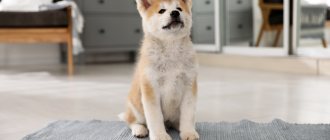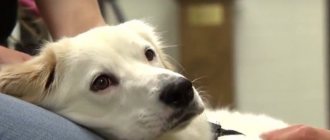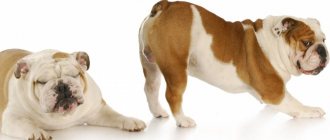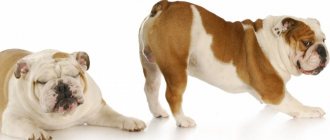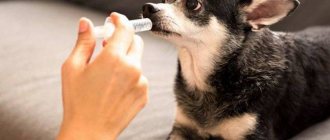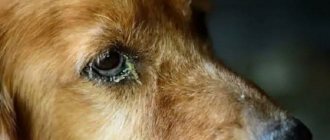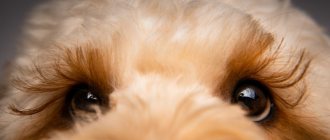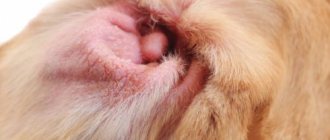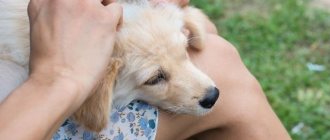Sometimes dog owners mistake problems of a completely different nature for urinary incontinence: emotional urination from joy or fear, polyuria due to hormonal diseases, extreme thirst or kidney failure. But true incontinence is the uncontrolled leakage of urine, without adopting a characteristic posture, without urge, completely involuntary.
To prescribe effective treatment, the veterinarian must first determine the causes of urinary incontinence in the dog. Owners usually come to the appointment in a timely manner, at the first sign of a problem: no one is ready to tolerate an unpleasant smell in the apartment and from the pet. The dog itself, which leaves puddles of urine in the apartment, suffers not only from a wet bed, but also physically. Leaking urine corrodes the skin, causing severe inflammation, and the slightly open bladder sphincter is a gateway to secondary infection. No amount of diapers or panties will solve this problem.
Incontinence in itself is not a life-threatening condition. But the scale of trouble is proportional to the size of the pet.
In this article, I will analyze in detail the diagnostic plan and possible treatment options for urinary incontinence in a dog. Author of the article: Olga Shiltsova, practicing veterinarian, author of the books “Dachshund of Fate” and “Tails of Fortune”
Congenital urinary incontinence in a dog
Some anatomical defects lead to incontinence from birth. Owners may not immediately detect the problem, because no one expects cleanliness from a small puppy and fur stained with urine is not a cause for concern.
Ectopic ureters
Constant drip leakage of urine in young animals is a reason to suspect improper location of the ureters. Normally, the ureters run from the kidney to the bladder. But it happens that the mouth of one or both ureters opens in the wrong place: into the neck of the bladder, directly into the urethra, vagina, uterus or vas deferens. Ectopic ureters can only be treated surgically. Technically, this is a complex operation and it does not always lead to a complete cure of the animal. However, surgery is necessary. Without surgery, the dog is at risk of an ascending urinary tract infection, which ends in pyelonephritis.
With unilateral ectopia, clinical signs may not be obvious and may also be disguised as other disorders. The average age at which a problem is detected is 10 months.
Functional insufficiency of the urethral sphincter
Weakness of the urethral sphincter can be congenital. In this case, urinary incontinence develops in a very young bitch, and after puberty (first heat) it usually goes away. If the owners have noted urinary incontinence in the puppy, castration may be contraindicated for the dog. After spaying, these animals are almost guaranteed to develop sphincteric urinary incontinence, and owners should be aware of this before deciding to neuter.
Read about the pros and cons of castrating female dogs HERE (link will open in a new tab).
Urinary incontinence in spayed bitches
Functional insufficiency of the bladder sphincter most often develops in neutered dogs of medium and large breeds. Weakness of the urethral sphincter is associated with low estrogen levels and can develop several years after surgery, in old age. Boxers, Rottweilers, Giant Schnauzers, Doberman Pinschers, Bobtails and some other dog breeds are predisposed to this problem. Obesity and a sedentary lifestyle increase the risk of developing the disease.
A characteristic sign of weakness of the urethral sphincter is urinary incontinence at rest: a puddle remains on the bed with normal urination during a walk and the absence of any other symptoms. The disease can occur in older, uncastrated female dogs (no more than 1% of the population) and in male dogs, but most often it develops in sterilized dogs (from 5 to 20% face this problem at different ages).
Contrary to popular myth, the likelihood of a female dog developing urinary incontinence after castration does not depend in any way on the surgical technique or the qualifications of the surgeon. The reason is considered to be a decrease in estrogen levels after removal of the ovaries.
Urinary incontinence is more common in older dogs
Prevention
If a young puppy, while following the feeding, drinking and walking regime, does not stop leaving puddles at home, and his bed is constantly wet, then it is likely that he has a congenital pathology in the structure of the urinary tract. An examination is carried out and the puppy is operated on.
The dog must be trained to walk at certain times. It is important to know that a female dog can empty her bladder at one time, but a male dog needs to cover a large area and leave urine marks in different places. The duration of his walk should be at least half an hour so that he can completely “walk”.
If the dog is very emotional, and his delight or fear manifests itself in incontinence, try to reduce the irritants. Behavior adjustments can be made at any age of your pet, but you will need persistence and patience.
If you have even the slightest suspicion of a disease, you should contact a veterinary clinic, conduct an examination and treat your pet strictly according to the doctor’s recommendation.
Overactive bladder
A truly rare but theoretically possible cause of urinary incontinence in dogs is an overactive bladder. A sign of a problem will be frequent urination in the absence of a proven infection in the urinary tract. In animals with this disease, the mechanism that regulates the contraction of the bladder is impaired, it reacts before it is full, and it becomes impossible to restrain the urge to urinate.
Bladder hyperresponsiveness is a diagnosis of exclusion. The doctor must be sure that the diagnosis of other causes of urinary incontinence has been completed in full and has not yielded results. There are specific drugs to normalize the frequency of urination in such patients, for example, Driptan (oxybutynin).
Paradoxical incontinence due to bladder overflow
Sometimes owners come to the appointment due to urine leakage, and upon examination it turns out that the bladder is simply full. This condition is not true incontinence, it is a consequence of urinary retention.
Overflow incontinence can occur in male dogs with prostatitis or urolithiasis. The lumen of the urethra narrows, the outflow of urine becomes difficult, the bladder overstretches and partial atony occurs (decreased wall tone).
The same picture occurs when the innervation of the bladder is disrupted: it is relaxed all the time, and urine leaks uncontrollably in small portions when it is extremely full. Neurological problems can be the result of injury to the spine or pelvic bones, or a herniated disc.
Behavioral features
Very often, the problem of urinary incontinence is associated with certain behavior, for example, fear or a conflict situation. A frightened dog can easily urinate if it feels threatened. Oddly enough, this most often affects young dogs, but as they age, they outgrow this problem. Neutered males can urinate, showing who is boss - simply marking. Sometimes age does play a role in an older dog who will begin to suffer from cognitive dysfunction. Such pets may simply forget that they live in the house.
Urinary incontinence in a dog: the causes can only be determined after examination
Even if the problem seems obvious, diagnosis should not be neglected. The dog should be taken to a veterinarian for examination. Be prepared for detailed questions in advance, because making a diagnosis always begins with taking an anamnesis. The veterinarian may be interested in:
- does the pet have awareness of the act of urination;
- time of onset of symptoms;
- when the leakage is more pronounced (during sleep, at rest or during movement);
- frequency of urination, volume, flow pressure, posture;
- whether the dog drinks more than usual;
- previous surgeries or injuries;
- whether the pet is taking any medications.
Take a video of the urination process to show your doctor!
After the conversation, the doctor examines the animal. Palpation of the bladder determines its size and tone of the walls. Be sure to examine the external genitalia, then perform a rectal examination (in male dogs, the prostate is palpated in this way).
After the examination, the doctor writes out directions for research:
- X-ray (will show stones in the urinary tract);
- Ultrasound of the kidneys and bladder (inflammation, neoplasms and other pathologies);
- general urine analysis;
- urine for bacterial culture (ideally collected by cystocentesis - puncture with a syringe through the abdominal wall);
- clinical and biochemical blood tests - if systemic diseases are suspected, in elderly animals (exclude diabetes, renal failure, etc.).
Large breed dogs are more prone to urinary incontinence after neutering
The doctor must explain why he prescribes each test. Otherwise, it may seem that they are simply taking money out of you. For example, bacterial culture. With urinary incontinence, infection may not be the cause, but a consequence of the problem. A slightly open urethral sphincter creates favorable conditions for the penetration of bacteria into the bladder and, if the problem is not solved, upward to the kidneys, up to pyelonephritis. Prescribing antibiotics to everyone blindly is not an option: there is a risk of growing resistant microflora, and the duration of the course also raises questions.
If ectopia of the ureters is suspected, a CT scan with a contrast agent (excretory urography) is performed, and urethrocystoscopy is performed in females. Both studies require special equipment and specialists. If this is not possible, an experienced uzologist can follow the ureter from the kidney to the point where it enters the bladder and thus confirm or refute ectopia.
Natural and harmless causes
Natural causes do not require serious medical or surgical intervention. In most cases, they go away on their own or are corrected with the help of training. These include:
- Sexual hunting
. Animals use scent marks to attract the opposite sex. This is a natural process that you just need to wait out.
- Polydipsia
. Increased thirst is a symptom of many diseases, but if it is explained by heat, everything is normal. In this case, it is enough to simply increase the frequency of walking.
- Lack of education
. If your pet is not accustomed to going outside due to his age, then this behavior is completely normal. Otherwise, the problem may be explained by resentment or other negative emotions. This behavior needs to be corrected.
- Excessive emotionality
. Small breed dogs often urinate with joy when they greet their owner returning from work.
- Weakening of the sphincter as a result of aging
. After 8 years, muscle tone decreases, weakening control over urine output. Despite its naturalness, you should not turn a blind eye to this problem. The animal's condition can be improved with the help of hormone therapy, avoiding lifelong use of diapers.
Regardless of the cause of incontinence, avoid punishment. They will not solve the existing problem, but will only aggravate the situation due to stress.
Drugs to treat involuntary urination in dogs
Urine leakage during the rest period is one of the characteristic signs of urethral sphincter weakness. If we are talking about a spayed female dog, the doctor may prescribe a trial therapy.
Propalin and its analogues
They use phenylpropanolamine: this is the drug “Propalin” or its budget analogue “Uristop”. To select the dosage, it is better to consult a veterinarian rather than the instructions.
“Propalin”: initial dose 1.5 mg/kg per day in 2-3 doses or the entire amount once. If there is insufficient effectiveness, you can gradually increase to 3 mg/kg per day; if there is no response to treatment, there is no point in increasing the dose of the drug further.
The drug is quite effective - it helps to cope with urinary incontinence in bitches in 75-90% of cases. It is prescribed less often for males, since their effectiveness is less than 50%.
Propalin must be given for life. It is a fairly safe remedy, although some animals may experience side effects.
In case of cardiovascular failure or high blood pressure, Propalin is prescribed only after consultation with a cardiologist.
If it is difficult to buy a veterinary drug, you can use a human medicine to reduce appetite: Dietrin (DietRin) contains 75 mg of phenylpropanolamine hydrochloride in each capsule, which corresponds to 1.5 ml of propalin.
Hormone replacement therapy
It also happens that “Propalin” does not work. Then estrogens are prescribed - female sex hormones. Spayed female dogs are prescribed estriol for urinary incontinence - this is the drug "Ovestin" and its analogues. It can only be prescribed by a veterinarian. In the first week, the dosage is 0.5-2 mg 1 time per day (large dogs require a lower dose per kilogram of body weight). Then the amount of the hormone should be reduced every week until the minimum maintenance dose is clear. For some animals, 0.5 mg once every 48 hours is sufficient for effective urinary control.
The use of estrogens is fraught with side effects.
The dog may show signs of estrus (swollen loop, attractive to males), and the uterine stump may become inflamed. Less commonly, true pyometra occurs if only the ovaries were removed during castration, leaving the horns of the uterus. With long-term use of hormones, it is necessary to regularly monitor the situation using ultrasound and blood tests. Hormonal therapy is contraindicated for breast tumors.
Good results in the treatment of urinary incontinence in sterilized bitches are achieved by the simultaneous use of propalin and estrogens.
Chemical castration drug: deslorelin
In addition to estrogens, Suprelorin, a subcutaneous hormonal chip, may be useful for weakness of the urethral sphincter in bitches. Most often, Suprelorin is used for chemical castration of males, and it is also indicated for urinary incontinence caused by low estrogen levels. "Suprelorin" is used in mono mode or together with "Propalin". The only downside of this treatment is the high cost - the implant must be re-inserted every 6-8 months, and its price reaches 6,000-8,000 rubles (as of 2022).
Suprelorin: implant and syringe pusher
Surgical treatment of urinary incontinence
If therapeutic treatment does not help with urine leakage, owners may even think about euthanasia - caring for the animal seems so unbearable to them. But if we are talking about a young dog, such a step is not justified. Sometimes the problem can be solved with surgery.
Endoscopic injections of collagen, hyaluronic acid and hydrogel into the bladder sphincter area.
The disadvantage of the procedure is that it has a temporary effect until the injected drug is absorbed (3-6 months), and sometimes it does not help cope with urine leakage at all. Efficiency ranges around 60-70%.
Advantages of the procedure: low trauma and visualization of the urinary tract to exclude related problems.
Colposuspension and cystourethropexy
The essence of the operation is that the vagina is pulled to the pubic bones with non-absorbable suture material. This repositions the bladder neck to help resist pressure as it fills. Surgery may help relieve incontinence symptoms, but the effect is temporary.
In cystourethropexy, the urethra and bladder neck are sutured to the symphysis. There is a technique in which the urethra is wrapped with a special synthetic loop to prevent overstretching and increase resistance to urine pressure.
Installation of an artificial sphincter
Artificial urethral sphincter implantation promises to become the gold standard among surgical techniques for the treatment of urinary incontinence in dogs. Unfortunately, this operation has not yet become widespread in Russia. To operate on a dog, you will have to contact the leading veterinary clinics in the country.
The system that is installed in the dog is sterile, made of biologically neutral material (does not cause rejection) and can remain in the body for life. A special cuff is placed on the urethra as it exits the bladder. It is connected by a tube to a port, which is brought out under the skin of the inner thigh or abdominal cavity. Using a syringe, fluid is pumped into the port and the cuff is compressed. By adding or decreasing the amount of fluid, the doctor adjusts the degree of compression of the urethra.
The artificial sphincter is equally effective in females and males suffering from urinary incontinence. The only downside of the operation is its high cost.
First aid
The first thing you should do is contact a veterinary clinic for a full diagnosis of your pet.
Attention! You should not give any medications from your home medicine cabinet to your pet. Even if it helped the neighbor's dog. You can only do harm.
All you need to do is provide your pet with enough water (especially if urination is frequent and little by little) and walk it more often.
If there is bad weather outside, if possible, provide the dog with a toilet in the house - lay out a diaper or show a tray (if the dog’s size allows it). The dog's place should be warm so that a draft does not blow in.
If urination is frequent, but without difficulty, in moderate quantities and the urine is normal (light yellow, transparent and without impurities), then it is worth considering that the dog may be under stress.
But even if nothing else bothers your pet, it’s better to play it safe and have his urine tested in a laboratory; perhaps they will find impurities that are invisible to the eye.
